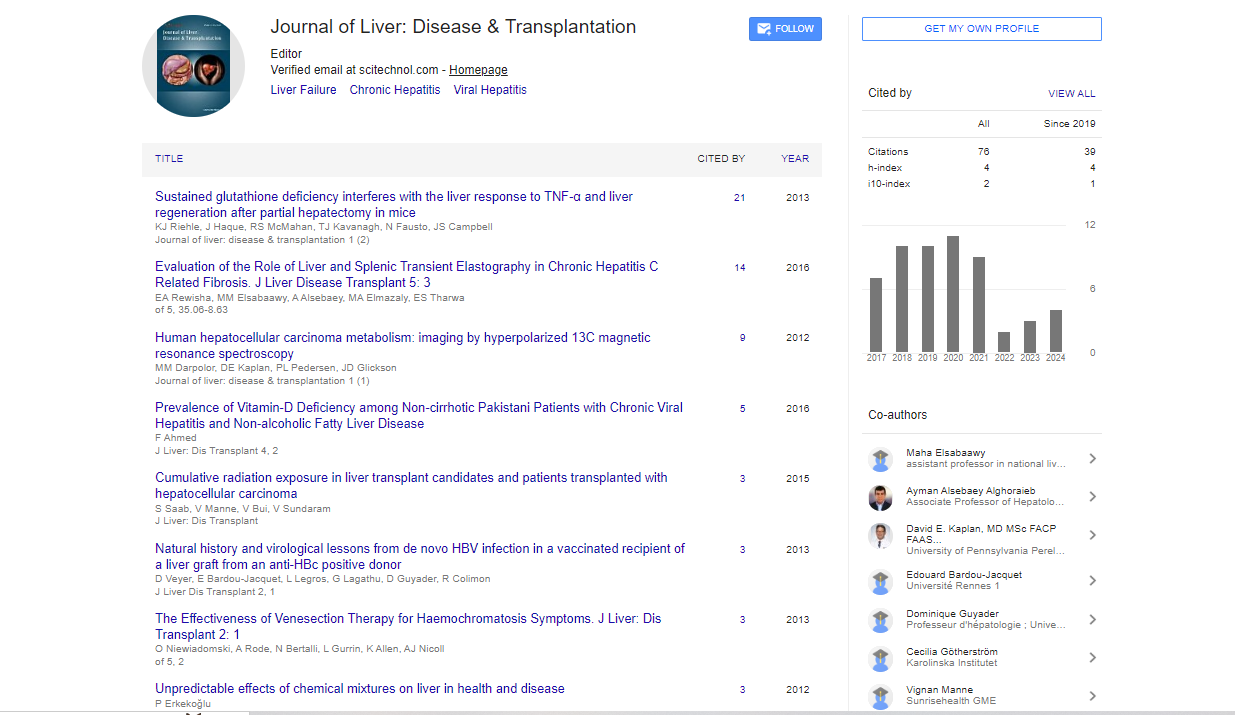Commentary, J Liver Disease Transplant Vol: 13 Issue: 2
Mechanisms and Implications of Genetic Mutations in Hepatic Disorders
Carolo Kras*
1Department of Hepatology, Johns Hopkins University, Baltimore, United States of America
*Corresponding Author: Carolo Kras,
Department of Hepatology, Johns Hopkins
University, Baltimore, United States of America
E-mail: krascar@lo.edu
Received date: 27 May, 2024, Manuscript No. JLDT-24-146993;
Editor assigned date: 28 May, 2024, PreQC No. JLDT-24-146993 (PQ);
Reviewed date: 13 June, 2024, QC No. JLDT-24-146993;
Revised date: 21 June, 2024, Manuscript No. JLDT-24-146993 (R);
Published date: 28 June, 2024, DOI: 10.4172/2325-9612.1000270
Citation: Kras C (2024) Mechanisms and Implications of Genetic Mutations in Hepatic Disorders. J Liver Disease Transplant 13:2.
Description
The liver, a vital organ responsible for numerous metabolic, detoxification, and synthetic processes, is influenced by genetic mutations. These mutations can lead to a variety of liver diseases and disorders, affecting liver function and pathology. Understanding the role of genetic mutations in liver health is important for developing targeted therapies and improving patient outcomes. Genetic mutations can impact liver function in several ways, often by altering the expression or function of key enzymes and proteins involved in metabolic processes. For instance, mutations in the CYP450 family of genes, which encode enzymes involved in drug metabolism, can lead to altered drug processing and toxicity. This can result in conditions such as Drug-Induced Liver Injury (DILI), where the liver is damaged due to the accumulation of toxic drug metabolites.
Another example is mutations in the UGT1A1 gene, which encodes the enzyme uridine diphosphate-glucuronosyltransferase. This enzyme is crucial for the detoxification of bilirubin, a byproduct of red blood cell breakdown. Mutations in this gene can lead to Gilbert's syndrome, a condition characterized by mild jaundice due to the accumulation of unconjugated bilirubin in the blood. Liver metabolism can also be affected by genetic mutations, particularly those involved in lipid and glucose metabolism. For example, mutations in the PNPLA3 gene are strongly associated with Non-Alcoholic Fatty Liver Disease (NAFLD). The PNPLA3 gene encodes a protein involved in lipid metabolism, and certain variants can lead to the accumulation of fat in liver cells, contributing to the development of steatosis, inflammation, and fibrosis.
Similarly, mutations in the HFE gene, which is involved in iron metabolism, can cause hereditary hemochromatosis. This condition leads to excessive iron absorption and accumulation in the liver, causing oxidative stress, hepatocellular damage, and eventually cirrhosis if left untreated. These examples highlight the critical role of genetic factors in regulating metabolic pathways within the liver and their implications for liver health. The pathological consequences of genetic mutations in the liver are varied, ranging from benign conditions to severe, life-threatening diseases. One of the most severe outcomes is the development of Hepatocellular Carcinoma (HCC), a primary liver cancer. Genetic mutations in oncogenes and tumor suppressor genes, such as TP53 and CTNNB1, are often implicated in the pathogenesis of HCC. These mutations can disrupt cell cycle regulation and promote uncontrolled cell proliferation, leading to tumor development.
Genetic mutations can also predispose individuals to autoimmune liver diseases, such as Autoimmune Hepatitis (AIH). For example, polymorphisms in the CTLA4 and PD-1 genes, which are involved in immune regulation, have been associated with an increased risk of AIH. These mutations may contribute to the breakdown of immune tolerance, resulting in the immune system attacking liver cells and causing inflammation and tissue damage. In hereditary liver diseases, such as Wilson's disease, mutations in the ATP7B gene lead to the accumulation of copper in the liver and other tissues. This accumulation causes oxidative stress and hepatocellular damage, which can progress to cirrhosis and liver failure if not treated with copper-chelating agents or liver transplantation.
Advances in genetic screening and personalized medicine have improved the diagnosis and management of genetic liver disorders. Genetic testing can identify specific mutations associated with diseases, allowing for early diagnosis and targeted treatment. For example, identifying mutations in the ATP7B gene in Wilson's disease can guide the use of copper-chelating therapy, while genetic testing for PNPLA3 variants can inform lifestyle interventions and surveillance strategies for individuals at risk of NAFLD. Moreover, pharmacogenomics, the study of how genetic variations affect drug response, has significant implications for liver disease treatment. For instance, patients with certain CYP450 gene variants may require adjusted dosages of medications metabolized by these enzymes to avoid adverse drug reactions.
Conclusion
Genetic mutations play an important role in determining liver function and pathology. They can influence various metabolic processes, contribute to the development of liver diseases, and affect the severity and progression of these conditions. Understanding the genetic framework of liver diseases enables more accurate diagnosis, personalized treatment, and improved patient outcomes. As research continues to uncover the complex interactions between genetics and liver health, new opportunities for prevention, diagnosis, and therapy are likely to emerge for management of liver diseases.
 Spanish
Spanish  Chinese
Chinese  Russian
Russian  German
German  French
French  Japanese
Japanese  Portuguese
Portuguese  Hindi
Hindi 